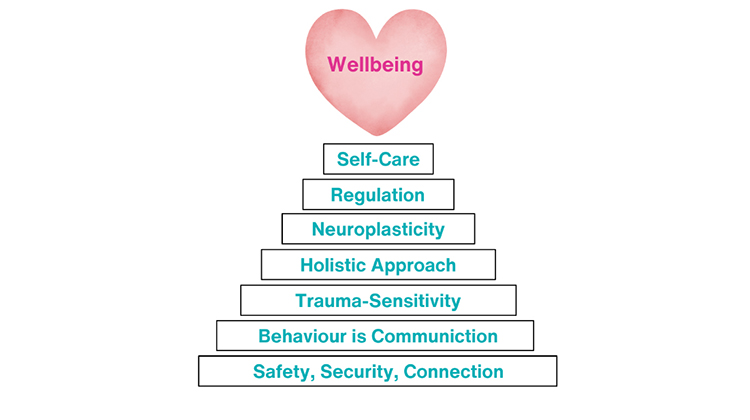Wellbeing Across the Educational Landscape - Article 1 Fundamental Wellbeing Principles

Welcome to the “Wellbeing Across the Educational Landscape” series. This series is designed to provide supportive and equitable access to a wide audience, including neurodivergent readers. This informs the information, language, font, colours, images and spacing used.
Understanding “Wellbeing Across the Educational Landscape” involves investigating wellbeing across diverse population groups and contexts. This first article discusses foundational wellbeing considerations, applicable to students and staff across the entire educational landscape. Be sure to download the FREE PDF of regulation strategies at the end of "Principle #6".
The remainder of the monthly series addresses wellbeing considerations specific to;
● Trauma-sensitive educational practices
● Students from different age groups and educational settings
● Educational staff
● Individuals who are;
○ Neurodivergent
○ Physically limited/disabled
○ LGBTQIA+
○ Indigenous peoples
○ Culturally and Linguistically Diverse (CALD)
**If reading this series or practicing wellbeing exercises causes you (or someone you’re supporting) distress, please take a break and seek support if needed. You can find professional support options at the end of this article.
I hope this series further supports the understanding, compassion and skills needed to appreciate and care for ourselves, and those around us.
Hence, I present 7 fundamental wellbeing principles. They may be helpful when considering your own, students’, or colleagues’ wellbeing support needs.
Principle #1 - Safety, security and connection are foundational to wellbeing
Safety, security and connection are universal human needs.
This is true for our students, community, colleagues, and ourselves.
Attachment theory identifies safe, attuned and consistently responsive relationships as essential to wellbeing, and development, throughout life. Supportive connections with adult caregivers (parents, teachers, coaches etc.) lead to secure attachment. Securely attached individuals can better meet physical, emotional, cultural and spiritual needs, leading to confident engagement in life, emotional regulation, growth, and thriving. Securely attached individuals are more able to empathise, set clear boundaries, express emotions, and use effective strategies to manage emotions, conflict and challenges.
Alternatively, inconsistent and unreliable caregiving leads to anxious attachment. Anxious attachment may be characterised by distrust and uncertainty in relationships, need for reassurance, difficulty respecting boundaries, and lower self-esteem. Anxiously attached individuals may be less likely to engage in cognitive reappraisal, which involves reframing an event to change its emotional impact.
Additionally, unresponsive caregiving leads to avoidant attachment. Avoidantly attached individuals are usually independent and self-reliant, untrusting of others, and resistant to help-seeking. They also tend to be uncomfortable with or suppress emotions, have lower emotional awareness, engage in emotional and cognitive distancing, avoid responding to challenges, and have decreased responsiveness in relationships.
Finally, traumatic, neglectful or abusive caregiving leads to disorganised attachment. Fear, abandonment and confusion lead to an internal conflict, where individuals internalise blame for their abusers’ behaviour, in order to maintain loyalty. Disorganised attachment may lead to unpredictable behaviour caused by simultaneously desiring and fearing intimacy, overanalysis of others’ actions, pulling away for self-protection, considering dependency on others as unsafe, feeling undeserving of love or care, and ‘switching off’ emotions.
Principle #2 - “Behaviour is communication”
Behaviour is therefore a physical representation of needs and processes happening within individuals, and between individuals. Much of this communication happens subconsciously, as individuals’ nervous systems assess and respond to danger detected from others, and in the environment. Behavioural communication is also contextual. The relationship between individuals affects the delivery and interpretation of communication.
This principle applies to students and colleagues. ‘Difficult’ or ‘disruptive’ behaviour is likely a form of communication, rather than an issue of non-compliance. Difficult behaviour may indicate an individual’s lack of capacity for self-awareness, self-regulation, or appropriate self-expression at that moment. These behaviours may, in fact, be unintentional autonomic nervous system stress responses.
Autonomic nervous system stress responses are largely inbuilt, subconscious and automatic responses to stress and trauma, driven by a perceived lack of safety. Information in the environment is detected through the 5 senses; sight, hearing, touch, smell and taste. Information within the body includes;
● Bodily functions (ie. heartbeat, breathing) and bodily sensations (ie. pain, hunger)
● The sense of our body in motion, including the body’s position, movement, use of force, and effort
● Our balance and the sense of our body in space, and
● Our 6th sense, intuition, or ‘gut feeling’, which tells us when something seems right or wrong.
How the nervous system responds to this information varies, depending on individual factors such as past experiences, current stress levels, coping strategies, and other resources.
When someone has adequate energy and resources to meet the demands of life, they are within their Window of Tolerance, and can better manage emotions and stress. Factors such as ongoing stress, trauma, chronic pain and being neurodivergent may push individuals outside their window of tolerance. Systemic and structural factors influencing the window of tolerance could include poverty, racism, sexism and ageism. When we are outside our window of tolerance our nervous system may initiate a stress response, to regain a felt sense of safety.
An individual may not be consciously aware that they feel unsafe, or that their nervous system is initiating a stress response. The survival part of their brain is in control, and overrides the areas responsible for emotional control, connection, reasoning, and learning.

FFFFF Stress Responses
Fight and Flight stress responses activate the body to respectively minimise, or avoid, perceived threat. The Fawn response attempts to please and appease the threat, while the Freeze response shuts the body down to hide from unavoidable danger. If the body gets too overwhelmed, it Faints.
 Individuals may habitually rely on stress responses that were helpful in the past, but are unhelpful in current situations. Or their nervous system may get stuck in certain trauma stress responses, by overestimating the presence, intention and force of perceived threats. For example, someone attacked by a dog may then feel scared of any dog, regardless of its size or behaviour.
Individuals may habitually rely on stress responses that were helpful in the past, but are unhelpful in current situations. Or their nervous system may get stuck in certain trauma stress responses, by overestimating the presence, intention and force of perceived threats. For example, someone attacked by a dog may then feel scared of any dog, regardless of its size or behaviour.
Principle #3 - A trauma-sensitive approach to wellbeing is critical
A trauma-sensitive approach to wellbeing;
● Acknowledges that trauma is widespread
● Considers things that could trigger subconscious stress responses (such as loud noises or sudden movements), and
● Monitors for behavioural signs of nervous system stress responses (FFFFF).
Extra care and consideration is required when supporting trauma-survivors. Anything related to their trauma experiences (ie. colour, smell, feeling or touch) could trigger a stress response, or re-traumatise the individual, especially practices involving;
● Movement
● Mindfulness or meditation
● A narrowed focus on body parts, sensations or functions, like breathing.
There is no ‘one size fits all’ wellbeing solution. We all have unique worldviews, experiences, needs, abilities and resources. Tasks that seem simple or helpful for some people, may be distressing or difficult for others. Trauma-sensitive wellbeing support is tailored to an individual’s unique circumstances.
 Therefore, an individual is the expert in their own life. Safe, respectful and person-centred support empowers the individual’s voice, choice, engagement, self-care, growth and resilience.
Therefore, an individual is the expert in their own life. Safe, respectful and person-centred support empowers the individual’s voice, choice, engagement, self-care, growth and resilience.
Please note: Article #2 in this series will address trauma-sensitive practices specific to educational spaces.
Principle #4 - Wellbeing is best understood holistically

The 8 Dimensions of Wellbeing highlight emotional, physical, occupational, social, spiritual, intellectual, environmental and financial health. These wellbeing dimensions are inter-connected, and can affect student and staff wellbeing and performance. Examples of dimensional inter-connectedness include;
● Social and Emotional Learning (SEL) programs may improve students’ cortisol, cardiovascular reactivity, brain functioning, and stress levels
● The Gut-Brain Axis explains how physical gut health can influence mood, cognitive function and mental health
● Occupational health services support sustainable health, wellbeing and working engagement, with a preventative focus on psychosocial risk management and mental health promotion
● Spiritually-based meaning supported adaptability in elderly adults during the CO-VID19 pandemic
● Youth with intellectual disability may be more likely to experience wellbeing issues, such as obesity and sexual health, as they transition into adulthood
● Urban green spaces mitigate the effect of Urban Heat Islands, addressing public health and wellbeing concerns regarding the environmental climate crisis
● Financial scarcity (including income inequality) is connected with adults’ lower life satisfaction and more negative emotions, depending on an individual’s perceived control and social connectedness.
Principle #5 - Neuroplasticity is our Superpower!
Neuroplasticity is the nervous system’s ability to change its structure, connections and functions in response to information. Neuroplasticity improves brain resiliency, and supports wellbeing and recovery from a wide range of physical, emotional and cognitive challenges.
 When the nervous system repeatedly detects information about something, the neural networks associated with that thing will increase in size and strength, especially when accompanied by strong emotions. Neural network reinforcement is contingent upon the frequency, intensity, attention and motivation related to experiences. Neural networks diminish when not reinforced through practice, or thought. You literally Use it, or Lose it.
When the nervous system repeatedly detects information about something, the neural networks associated with that thing will increase in size and strength, especially when accompanied by strong emotions. Neural network reinforcement is contingent upon the frequency, intensity, attention and motivation related to experiences. Neural networks diminish when not reinforced through practice, or thought. You literally Use it, or Lose it.
As discussed in Principle #2, our nervous system automatically and subconsciously identifies threats to safety.
We can reverse-engineer this subconscious process to our advantage!
 For example, many people have a slower heartbeat and breath when they feel safe and secure. Therefore, if someone is distressed they might try slowing their breathing, which slows their heart rate, which signals ‘safety’ to their nervous system. Practicing regulation and effective stress responses when calm strengthens neural networks. This supports helpful automatic skills and behaviours when stressed, replacing habitual or unhelpful thoughts and behaviours.
For example, many people have a slower heartbeat and breath when they feel safe and secure. Therefore, if someone is distressed they might try slowing their breathing, which slows their heart rate, which signals ‘safety’ to their nervous system. Practicing regulation and effective stress responses when calm strengthens neural networks. This supports helpful automatic skills and behaviours when stressed, replacing habitual or unhelpful thoughts and behaviours.
 Additionally, wounded attachment systems (which may be deeply entrenched and change-resistant) can be healed, leading to secure attachment skill development and experiences.
Additionally, wounded attachment systems (which may be deeply entrenched and change-resistant) can be healed, leading to secure attachment skill development and experiences.
This is neuroplasticity in action! In these examples, we are reinforcing neural networks related (but not limited) to; the physiology of being safe and calm (slow breathing, slow heartbeat), safe and secure interpersonal experiences, self-efficacy to manage stress and wellbeing, and having an internal locus of control (power over what happens in our life).
The past does not have to dictate the future.
 Furthermore, the brain encodes real and perceived stimuli similarly whereby perspective-taking, imagination, creative arts and symbolism can be used to strengthen helpful neural networks.
Furthermore, the brain encodes real and perceived stimuli similarly whereby perspective-taking, imagination, creative arts and symbolism can be used to strengthen helpful neural networks.
Principle #6 - Regulation supports wellbeing
Principle #2 taught us that we cannot learn, or perform well, when we are having a FFFFF stress response.
First we need to regulate, then we can get on with life.
Co-regulation is the process of providing attuned and responsive caregiving to someone in distress, so that they feel Safe, Seen, Soothed and Secure. Therefore, co-regulation involves practicing compassionate active listening, regulation skills, and managing environmental stressors. Over time, co-regulation supports self-regulation competencies to manage thoughts, emotions and behaviours.
Give a man a fish, and feed him for a day.
Teach a man to fish, and feed him for a lifetime.
However, individual differences including needs, context, capacities and attachment styles require a personalised approach to co-regulation.
#1 Rule ~ Ask what someone needs in that moment
Don’t assume, or disregard.
The guidelines and suggestions provided must take into consideration
individuals’ unique needs and circumstances.
Energy Needs
Individuals experiencing Fight, Flight and Fawn stress responses receive a rush of adrenaline to take action against danger. Therefore, regulation strategies which discharge extra energy are required, before their nervous system can calm down. Conversely, individuals in Freeze or Faint will have low energy, and need to slowly increase their energy without getting overwhelmed.
Context
Strategies used to discharge or increase energy, or regulate emotions, need to match individuals’ resources and circumstances. Strategies can range from small and discrete to whole body movements, be done alone or with other people, and use materials if available.
Capacities
Capacities include physical, emotional, cognitive, social, spiritual, environmental, financial, material and occupational resources or limitations.
Attachment Styles
All individuals need a choice and voice about what helps them feel safe in any given moment. We are all also on a lifelong journey of growth and development, and may need emotionally corrective relational support and modelling. This includes support to appropriately increase energy to take action, and decrease energy through co-regulation or self-soothing to calm down. Support may also be required to tolerate and then lower difficult emotions, or tolerate and increase pleasant emotions. All individuals benefit from co-regulation, however the process varies for different attachment styles.
Securely attached individuals may better tolerate, engage in, and benefit from direct and reciprocal, verbal and non-verbal communication. This includes identifying and expressing needs and emotions, open body language (ie. direct eye contact, smiling, facing each other), and physical touch.
Anxiously attached individuals may benefit from reassurance, experiencing consistent support, and open body language to signify sincere and trustworthy communication. Practicing cognitive reappraisal, respecting boundaries, and expressing emotions appropriately are also helpful.
Avoidantly attached individuals may benefit from getting personal space, and less confrontational side-by-side (rather than direct) communication, especially males. Support to identify, tolerate and express emotions, practice help-seeking behaviours, engage reciprocally in relationships, challenge their inner critic, and take an objective, solution-oriented approach to challenges, is also helpful. Mentalisation (identifying and empathising with one's own and others’ emotions) may support development of these skills.
Disorganised attached individuals in particular need support to define, and engage in, ‘safe’ personal space and interpersonal interactions. Practicing boundary-setting to increase safety, autonomously increasing choice and control, communicating feelings and needs, and nurturing interdependent relational dynamics are helpful.
Please note: it’s difficult to offer secure attachment experiences if you havn’t experienced secure attachment yourself. These supports may be helpful.
The Vagus Nerve
The vagus nerve is an information highway between the brain and various internal organs, including the Gut-Brain Axis. It is responsible for bodily functions including heart rate, digestion, immune function, and mood. Vagus nerve stimulation can help regulate stress responses, and improve mood and can include; cold water, deep and slow breathing, yoga, meditation, using your voice, massage, social connection, and diet.
Connecting our Whole Brain
As outlined in Principle #2, stress responses are initiated by our survival brain, and interfere with our regulation, relational and reasoning capacities. Regulation strategies to re-engage these brain areas include; whole body movement, creativity, story-telling, answering questions, problem-solving, remembering, and focussed attention.
(Due to limited capacity within this article, please research or follow links to extend your understanding of specific topics, and download a table of regulation strategies.)
Principle #7 - Self-care is a priority
You can’t pour from an empty cup.
 In order to support student and staff wellbeing, we can’t be running on empty. We need to have energetic, emotional, cognitive, social and skill resources before we can share them with others.
In order to support student and staff wellbeing, we can’t be running on empty. We need to have energetic, emotional, cognitive, social and skill resources before we can share them with others.
We need to take care of ourselves, before we can take care of others.
Consistent engagement in enjoyable and regulating activities is essential for maintaining our own wellbeing, and building resources to support others. Improved self-awareness will help with identifying and managing stressors, and seeking support when needed. Work-life balance, in a way that meets your needs and values, is helpful. If alcohol, cigarettes or other substances are used to manage workload or stress, more healthy and helpful support options could be considered.
In closing, a point of reflection;
● Is there anything in this article that stood out as a wellbeing need for you?
● Is there something you enjoy doing that you have not done for a long time?
● Is there an area of your wellbeing that’s been neglected lately?
● What’s 1 thing you can do this week to support your wellbeing?
Stay tuned for Article #2 in this series; “Trauma-Sensitive Educational Practices”
With best wishes,
Kim
(The information in this article is not intended as medical advice. For persistent stress or specific support, professional healthcare is advised.)
Support Organisations (Australia);
● If you live outside of Australia, search the internet for "wellbeing support services"
● If you are ever in danger call "Emergency Services" (In Australia call - 000)
● Your local doctor, counsellor, or other healthcare professional
● If you don’t feel like talking, you can text Crisis Support - 0477 131 114
● Headspace - 1800 650 890
● Beyond Blue - 1300 22 4636
● Mensline - 1300 78 99 78
● Lifeline - 13 11 14
● Griefline - 1300 845 745
● Sexual Assault Crisis Line Victoria - 1800 806 292
● DirectLine (impacted by drug use) - 1800 888 236
● PANDA (Post or ante natal depression) - 1300 726 306
● LGBTI Switchboard - 9663 2939 or 1800 184 527
● Safe Steps (family violence support) - 1800 015 188
● Gambler's Help - 1800 858 858
● Bush Support Line (People in rural and remote areas) - 1800 805 391
● Nurse On-Call - 1300 60 60 24
● Parentline - 13 22 89
Kim Vanderwiel ~ BA-BEHP(Psych), GDipCouns, AdvCert Guiding & Teaching Meditation & Mindfulness (In Progress) has a background in clinical research, counselling, mindfulness and meditation, and is the founder and CEO of the Practical Wellbeing Institute. Kim has supported the wellbeing of young people and adults with different identities, needs and experiences, including; mental health challenges, trauma, neurodiversity, learning difficulties, LGBTQIA+, and multiculturalism. Kim is particularly passionate about supporting post-traumatic growth, and flourishing.